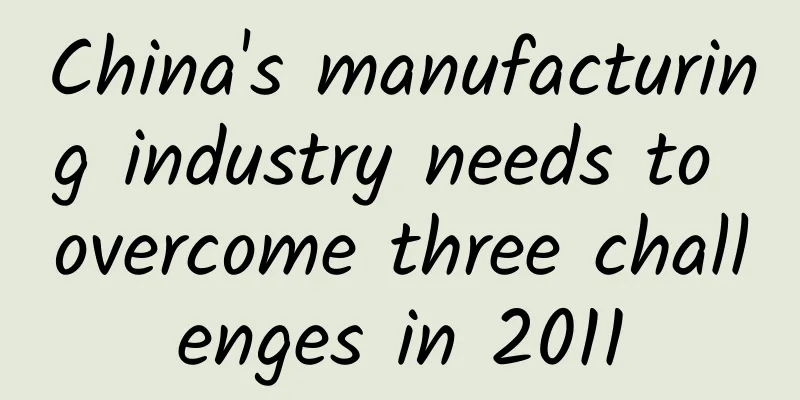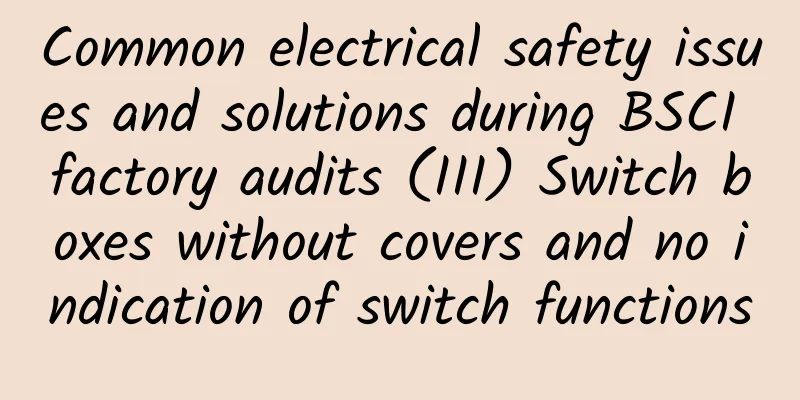China's manufacturing industry needs to overcome three challenges in 2011

|
As the Spring Festival approaches, manufacturing companies in Zhejiang and other places are reporting a labor shortage, which has once again put China's manufacturing industry at risk. From the labor shortage, exchange rate war, and trade war at the beginning of this year to the cost pressure brought by inflation in the second half of the year, China's manufacturing industry has encountered huge challenges this year. The coming 2011 will not be an easy year for the manufacturing industry. In the words of foreign media, China's manufacturing industry, which is in a period of transition, will face more difficulties next year. Faced with internal and external difficulties, analysts say that if China's manufacturing industry wants to resolve possible risk factors as soon as possible, it must find ways to produce high value-added products. As early as late June this year, the US economic consulting company Global Vision published a report predicting that in 2011, China's manufacturing industry will surpass the United States to become the world's number one, thus ending the United States' 110-year position as the world's number one manufacturing kingdom. Although it remains to be seen whether this prediction will come true, it is enough to illustrate the vigorous development of China's manufacturing industry in recent years. However, the future development of China's manufacturing industry is likely to be not smooth sailing. The first problem facing China's manufacturing industry is the labor problem. According to an article published on December 9 in the Financial Times, China's manufacturing industry is currently facing a serious labor shortage. According to official data, the labor shortage in the Pearl River Delta, an export processing industrial base, is as high as 900,000, and this trend is spreading to the entire southeast coastal area. Due to the rising cost of housing, education and living, many migrant workers from the inland areas feel that although the income from working in the coastal areas is higher, after deducting these expenses and considering the price gap between the coastal areas and the inland areas, the benefits are limited. The article points out a way out for the relocation of manufacturing industries, but also admits that there are many bumps on this road. According to the National Broadcasting Corporation of the United States, due to the rising manufacturing costs in mainland China, many multinational companies are moving their production bases to other places with cheaper labor, such as Indonesia, Vietnam and Cambodia, which have become the new round of beneficiaries. Their processing industries, which were hit hard in the last round of the Southeast Asian financial crisis, are recovering rapidly, posing a challenge to China's traditional manufacturing bases in the fields of footwear, textiles and clothing, food and electronic products. As the CEO of a US footwear group, Rubel, said, China was once a one-stop shopping utopia, but "utopia is doomed to not last long." Although China's manufacturing industry is trying to upgrade its industrial structure, and these new manufacturing bases have a large gap with China in terms of infrastructure and labor cost-effectiveness, all this has undoubtedly increased the uncertainty of the development of China's manufacturing industry in 2011. Currency war intensifies Compared with the labor shortage, the appreciation pressure faced by the RMB is a greater test for the manufacturing industry. In 2010, the US pressure on the RMB exchange rate showed a trend of increasing step by step. As the trade surplus between China and the United States continued, the US government became more and more impatient. A vivid example is the attitude of Treasury Secretary Geithner. In May this year, during the second round of China-US economic strategic dialogue, although he also expressed his hope that the RMB exchange rate reform would accelerate, he still emphasized "respecting China's exchange rate autonomy." However, in October, before the US mid-term elections, facing the decline in the support rate of the Democratic Party and the increasingly severe economic and unemployment rates, Geithner's tone in Congress became tough. On October 6, he even directly threatened that "it might trigger a trade war." Not only that, he also issued an ultimatum to the IMF, threatening that if it could not take a more effective stance on the issue of China's exchange rate, it might lose the support of the United States on a series of issues. Bloomberg News analyzed that the reason why the United States is pegging the RMB exchange rate, and some people even say that "a 100% appreciation of the RMB is not enough", is that it is targeting China's increasingly developed manufacturing industry. Many Americans hope to force the RMB to appreciate, making Chinese manufacturing uncompetitive, thereby reducing the United States' imports of industrial products from China and reversing the trade deficit. Since China has become the "world's factory", many countries have this idea to varying degrees. Trade frictions will not stop If the exchange rate issue is an indirect expression of dissatisfaction between Europe and the United States with the rapid development of China's manufacturing industry, then the trade war is a direct countermeasure against China's manufacturing industry. Throughout this year, the United States has erected unprecedented trade barriers against Chinese-made products. Statistics show that China continues to be the biggest victim of US anti-dumping measures this year, with as many as 24 new lawsuits in the first half of October alone. Since entering December, the United States has successively implemented or extended "double-reverse" measures on Chinese paraffin, multi-layer solid wood floors, and wooden bedroom furniture. Not only that, countries and regions such as the European Union, India, Argentina, and Mexico have also had trade frictions with China, among which India has become the country with the most complaints to the World Trade Organization about "Made in China". Reuters analysis said that in 2011, trade war measures against China's manufacturing industry will increase rather than decrease, and the root cause of the trade war is the strong market competitiveness of "Made in China", so China's manufacturing industry will have to continue to deal with various trade wars next year. Inflation adds to cost pressures The increasingly severe inflation situation is also testing the manufacturing industry. Internationally, the transmission effect of rising prices of commodities such as soybeans, cotton, and copper is becoming apparent. Domestically, China's CPI rose 5.1% year-on-year in November, higher than 4.4% in October and the 3% target set at the beginning of the year. Analysts predict that this situation will continue into next year. Japan's Sankei Shimbun analyzed that "the trend of medium- and long-term inflation has pushed up the cost-price ladder", which will cause China's domestic industrial enterprises that originally won by scale and price competition to fall into trouble, "which is undoubtedly destructive to China's adjustment and upgrading plan for the manufacturing industry." In addition, analysts at Credit Lyonnais in France said that if the Chinese government uses the most effective weapon to fight inflation, interest rate leverage, to raise interest rates on a large scale and frequently next year, the cost of China's manufacturing industry will rise sharply, and the profits of many low-end manufacturing companies will be wiped out or even become negative. However, as the French newspaper Le Tribune analyzed, the deposit reserve ratio measure has gradually lost its lethality after frequent use in 2010, and the issuance of new central bank bills has encountered subscription resistance, the government may eventually have to use the interest rate lever to control inflation. Once this happens, China's manufacturing industry will be forced to bear greater cost pressure due to anti-dumping barriers, rising exchange rates and punitive tariffs, and internally due to rising interest rates. Faced with labor shortages, pressure on raw material costs and exchange rate wars, the Nihon Keizai Shimbun said that "Made in China" which is pursuing horizontal expansion in the existing industrial and export division of labor levels may feel that "the higher you go, the tighter your neck may be" in the new year. The German Economic Network also analyzed that the difficult 2011 is a critical juncture for China's manufacturing industry. Ding Yifan, a researcher at the Development Research Center of the State Council, said that for China's manufacturing industry, it is necessary to upgrade and replace, and it can no longer be satisfied with importing products and simply assembling them. In fact, this change has already happened quietly. A recent analysis article in the British "Times" stated that now there are more mobile phones, computers and other high-tech products in export containers from China. Today, after the global manufacturing center has shifted to Asia, China is constantly transforming from an extensive export economy to an economy with high value-added products with its competitive labor market and global development vision. Therefore, as the investment experts of BNP Paribas said, China's rapid development in the export industry is not entirely China's choice, but the global economy with high demand has chosen China. |
<<: Pearl River Delta toy companies downsizing and transformation model
>>: Made in China needs to speed up its pace
Recommend
Introduction to Shopify Platform—What is Shopify?
What is Shopify? Shopify was founded by Tobi Lütk...
Shanghai Enterprise Wage Payment Method
These Measures are formulated in accordance with ...
Opinions on BSCI factory audit attitude towards wages
BSCI's attitude towards wages November 2009 In...
Interpretation of eBay US site policies, eBay sellers click here!
Understand the policies of eBay US site, enter th...
What are the Matson Clippers? Why are they so fast?
What are the Matson Clippers? Matson Express was ...
The world's first quantifiable "zero-carbon factory" standard has been officially released! Check it out!
On June 5, World Environment Day, Unilever and mo...
About EICC certification scoring standards
In the EICC certification audit, whether the supp...
Home Depot closes stores in China and completely withdraws from China
Recently, a piece of news spread on the Internet:...
Bon-Ton factory inspection consultation content standards
This Code of Vendor Conduct applies to vendors/sup...
SA8000 helps Chinese enterprises truly go global
SA8000 helps Chinese enterprises truly go global ...
Pepper Content—Intelligent content matching platform
What is PepperContent? Founded in 2017, PepperCon...
What is Baoshijia? What service cooperation does Baoshijia provide?
Shenzhen Baoshijia Technology Co., Ltd. was estab...
What are the eBay product selection research tools? What are their functions?
Solve the problem of eBay product selection, and ...
eBay platform classroom, what are the characteristics of eBay?
As an international retail cross-border e-commerc...
What is Elastic File Service (SFS)? Product advantages of SFS
Scalable File Service provides a fully managed sh...









